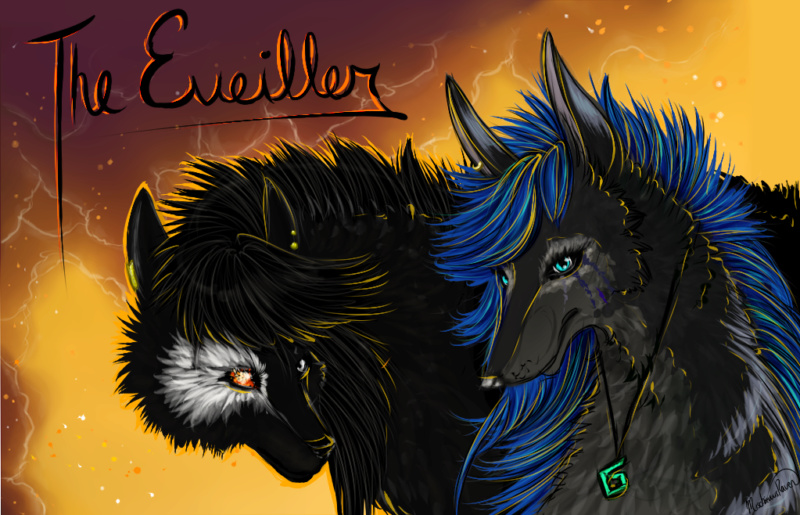Aiastes
(s., pl.)
General Information
This species lives in an area with a viral disease which runs rampant throughout the region. The illness, known to the locals as “Yellow Death”, kills approximately half of all cubs born. Unknown to the Aiastes, this is due to an allele which determines whether an Aiastes will be resistant to this infection, will be susceptible, or will be born with a congenital defect which is always fatal.[1]
Those who receive the congenital defect are either stillborn or die within their first few weeks. The disease, which is carried by various insect parasites, kills all susceptible wolves within their first year of life, due to the life cycle of the vector parasites. For this reason, the Aiastes do not receive a name until they have turned one year old.
“Yellow Death” causes acute renal and hepatic failure, and although death is relatively quick after the onset of symptoms (a few days to a week), it is very unpleasant to suffer through and the community often does the sick a service by ending their lives if requested. This request is often given to a close family member or friend of the terminally ill.
The disease gains its name from the icterus of its victims. Other symptoms may be found under the appropriate heading
HERE and
HERE.
With this curse comes a blessing; in those who survive the sickness, the viral disease’s replication process creates a second genetic mutation which slows the aging of the Aiastes. Females tend to age more slowly than males and generally live longer. Males live as long as 200 years, and females can reach 300 or more.
Physical Description
On the "small" side of the wolf scale, with males averaging 75-80cm (30-32in) at the shoulder and 70-100 pounds, and females averaging 70-75cm (27-30in) at the shoulder and 60-90 pounds.
Coat varies from fawn/tawny to dark brown/black and may contain multiple colors. Markings (especially on the face) are common and usually a bright color. They can be found in variations of the main coat colors, or yellows, oranges, (natural) reds, white, grays, and occasionally black. Neon colors, blues, and greens are not seen.




Culture
Those who receive the congenital defect are either stillborn or die within their first few weeks. The disease, which is carried by various insect parasites, kills all susceptible wolves within their first year of life, due to the life cycle of the vector parasites. For this reason, the Aiastes do not receive a name until they have turned one year old.
Cubs are referred to as "Cub," "Whelp," or "Anonymia" or some variation thereof (Mia, Nymia, Nony, etc), or are referred to by their parents' names (Bear's Son/Bearsson, Birch's Daughter/Birchdaughter/Birchdotter). Yearlings' names are often based around attributes those individuals have shown or feats they have accomplished, or are traditional family names passed through many generations.
Because half the cubs which are born will die, starting a family can be daunting. A birth is as much a celebration as a preparation for mourning. For this reason, many couples choose to only go through the process a time or two, if at all; youngsters are rare, and the species’ general population is therefore relatively small.
A typical litter consists of 3 to 8 cubs.
The species is divided into several packs, each consisting of 20-50 individuals. Their culture is generally close-knit and pack oriented. Due to the small population, there is a good bit of cross-mating between the packs to prevent inbreeding. Young males will often travel between the packs to search for a mate, and will convert to the new pack when one is chosen. Because males will travel and leave the home pack, the packs tend to be matriarchal and bloodlines are traced through the mother. Females will occasionally move between packs or return with a male, but it is not the norm.
Since the packs have many familial ties, there is little conflict among them.
The species is able to interbreed with normal wolves and similar species which are also able to interbreed with normal wolves. However, this combination is rare in their indigenous area because “wild type” wolves are susceptible to the disease Aiastes have developed immunity to. Wolves only travel through the region during periods when the vector insects are inactive. In addition, Aiastes rarely leave their homeland or take interest in those outside their own kind due to their isolation.
Annotations
[1] This is similar to the inheritance of sickle-cell anemia genes which permit immunity to malaria in humans; two alleles for normal cells causes susceptibility to malaria, two alleles for sickle cells causes sickle cell anemia, and one of each provides resistance to malaria while maintaining enough correctly-shaped cells to avoid the problems caused by sickle cell anemia.
(For those who have not reached this level of science education in school, you can read about it
HERE)
The gene works by simple allele inheritance which may be demonstrated with a Punnett square where:
R = dominant resistance allele
r = non-dominant resistance allele
and
RR – Congenital Defect (lethal)
Rr – Resistant
rr – Susceptible (lethal)

The Aiastes are my own creation; please do not copy or create a character of this kind without direct permission.
